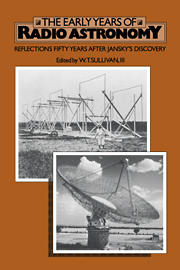Summary
The final section consists of a group of articles addressing the early development of radio astronomy in various broader contexts. David Edge, a radio astronomer turned sociologist of science, has frequently used his former field as a case study for achieving new insights into the social forces which make science what it is. In his present contribution he summarizes a portion of this work as it applies to the contrasting styles of research found at Cambridge, Jodrell Bank, and Sydney.
William McCrea never himself became embroiled in the 1950s controversy over radio source counts and their cosmological implications, but he was there as it all happened. In his article he traces the development of cosmology in the twentieth century, in which he himself played a major role, and then discusses how the new radio data affected the cosmologist's perception of the Universe.
In the third article Hendrik Van de Hulst does not so much write about his own substantial contributions to radio astronomy, but rather examines how ideas in astrophysics evolve over a period of decades, that is, with frequencies in the nanohertz range. Although this frequency range is somewhat lower than radio astronomers normally consider, he argues that in fact such long-term changes, often overlooked, are vital to the proper understanding of the development of a science.
Owen Gingerich, trained as an astrophysicist and now an historian of science, closes the volume with a look at radio astronomy's overall effect on twentieth-century astronomy.
- Type
- Chapter
- Information
- The Early Years of Radio AstronomyReflections Fifty Years after Jansky's Discovery, pp. 349 - 350Publisher: Cambridge University PressPrint publication year: 1984

